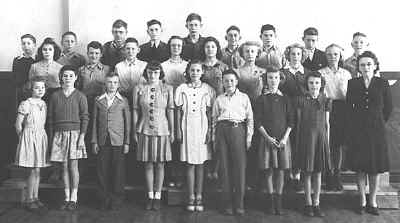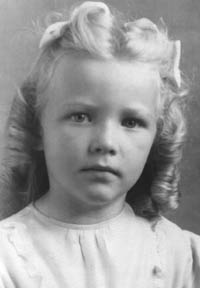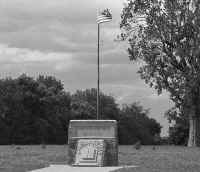|
July 2001 |
|||
|
|
|||
|
|
|||
|
RHS Class of 1951 Holds 50th Anniversary The Rolfe High Class of 1951 held its 50th anniversary class reunion the weekend of July 14th in the Rolfe area. The planning committee consisted of John Young and Nancy Shelgren Martin, both of Rolfe, Eddie Wilcox of Algona, and Jeanette Alig Koschorreck of Ames. Fourteen classmates and three teachers gathered on Saturday morning for the Greater Rolfe Days parade then ate at the Lutheran Church where the V.F.W. served lunch and the Lutheran women served pie and ice cream. The group then toured the school building and headed for Algona to relax at Eddie's home before a banquet at the Prime Time Restaurant. Three members of the class came from California — a fourth from Orlando, Florida and a fifth from Chicago, Illinois, and the rest from Iowa. Nancy says the most fun was when Eddie got out a large map of Rolfe and had the reunionites identify the names of streets and locations of business that existed in the town when they were seniors. He later pointed to ads from 53 Rolfe businesses, including five gas stations and three grocery stores, that were published in the back of the 1951 yearbook. Jeanette (formerly known to some as Jeanette Winkleblack) wrote the following about the reunion. |
|||
|
A Golden
Reunion "On a clear day, you can see forever!" That's what happened in Rolfe, Iowa on July 14th, 2001. The Class of '51 was in town to have some fun. We looked into the lives, past and present, of our classmates and paused to remember those who were deceased. "Oh, my gosh," was the quote of the day as we saw people whom we had not seen for 10, 20, 30, even 50 years. To be a kid again watching a parade, catching candy and dodging water balloons was reminiscent of younger days. The teachers who joined us had as much fun as we did trying to recall classroom locations, "back in those days" as we toured the school. We all felt the school, being 16 years older than us, is as well preserved as we are. Ours was the last class to graduate from the original building. A stop at the Wilcox residence on Oak Lake was "the pause that refreshed." Then the big one — the banquet! Yes, sometimes it sounded like a fisherman's banquet as the stories grew and grew. Roll call was answered to Mr. Chamber's, "Sir." A trip down memory lane recalling all the business places on Main Street the year we graduated was amazing. The Prime Time Restaurant provided a perfect spot and good food for the conclusion of our day. At coffee Sunday morning, some bid farewell and others left to attend the church service at Streit Park back in Rolfe on a beautiful summer morning. As we all sang "God Be With You 'Til We Meet Again," a few tears were shed. The aroma of food cooking filled the air and drew us to the Fire Station. There we ate pancakes and said our final farewells as the words of our class song, "So Long It's Been Good To Know You" came to mind. |
|||
|
|
|||
|
Reflections on the Des Moines Township Consolidated Schools The recent all-class reunion of the Des Moines Township Consolidated Schools prompted us to feature the D.M.T. experience. First, there is the great photo above from 1916 when the township brought its one-room schools together at a central site. The photo is from the Karen Truelsen Kerns collection and is by N.A. Nielsen who was known as the "Bee Man" to many people in the Rolfe area. To get a closer look, we have provided separate views of the left, middle, and right sections of the photo. Next we have a brief history of D.M.T. written circa 1968 by former RHS superintendent Charles Underwood. Then there is Karen's written report on this years reunion. She is a 1957 graduate of D.M.T. and a resident of rural Rolfe and was co-chair of the event with Loren Thompson. Her husband, the late Curt Kerns who was killed in recent years in an automobile accident on the way to a Pro Coop annual meeting, was a 1954 graduate of Rolfe High School. |
|||
|
D.M.T. Voted
in 1916 to Create a Consolidated School District The history of the Des Moines Township Consolidated School District officially begins with a special meeting on April 14, 1916, of the Board of Directors of the Des Moines School Township. Said board was made up of the directors of the subdistrict rural independent one-room schools. The directors were: Subdistrict No. 1, G. D. Sturthers; Subdistrict No. 2, C. W. Carpenter; Subdistrict No. 3, T. O. Thorson; Subdistrict No. 4, B. J. Lehnus; Subdistrict No. 5, R. W Maxson; Subdistrict No. 7, H. H. Willard; Sub district No. 8, Arthur Vaughn. W. S. Watson was secretary. During the above mentioned meeting it was decided to call a special school election for the purpose of voting on the consolidation of the rural independent school districts in Des Moines Township. The consolidation was to include all of Des Moines Township except the South 1/2 of Section 31, Section 32, the West 1/2 of Section 33, plus 40 more acres of Section 33. The special election was held April 29, 1916, with 108 persons voting. There were 62 "yes" votes and 46 "no" votes cast on the proposition "Shall the proposed Consolidated Independent District of Des Moines Township be established ?" Another special election was held May 20, 1916, for the purpose of electing directors of the new district. Those elected were: W. E. Struthers, F. D. Woodruff, J. F. Spangler, A. W. Ralph, G. D. Struthers. When the new district came into being July 1, 1916, W. E. Struthers was selected as president and Charles Tempelman was elected secretary. A school site was purchased and a special school bond election in the amount of $40,000 for the purpose of erecting a new school building was held September 30, 1916. The bond issue passed by a vote of 131-90. The first superintendent was John Stirling. The general building contract was awarded to B. L. Stralton of Mason City on March 26, 1917, for $30,749. Fort Dodge Plumbing and Heating was awarded the plumbing, heating, and ventilation contract for $9,135. For some reason not apparent in the official minutes, contracts were again let for the new building May 22, 1917. The general contract went to J. J. Peterson of Waterloo for $35,394. The building was completed and occupied during the year 1918. Another bond issue of $16,000 was passed by vote of 33-1 on February 2, 1918, for the purpose of completing and equipping the school house. In 1919 the first senior class of five members graduated from the school. The members of this class were: Chester C. Harris, Vinton Stinton, Charles H. Lehnus, William R. Fisher, Melvin E. Struthers. Professor Edwards resigned in 1920 and was followed by these men: F. O. Hoffman, 1920-21; W. G. Byerhoff, 1921-23; G. W. Gotke, 1922-23; L. D. Morgan, 1924-26; M. L Merritt, 1926-28; C. R. McIntire, 1928-32; Gerome M. Gehit, 193238; Roy E. Jennings, 1938-39; I. K. Martin, 193941; G. D. DeBoer, 1941-46; A. W. Norgaard, 1946-48; A. O. Garlock, 1948-51; H. L. Ericson, 1951-53; L. H. Propst, 1953-58; C. I. Bixler, 1958-59; Principal Paul Nagel, 1959-60. A special $7,500 school bond issue election was held August 5, 1954, for the purpose of building a new gymnasium and the remodeling of several rooms in the original building. The vote was 134-74 in favor. Anderson Construction Co. of Emmetsburg was awarded the general contract for $56,790. Henry Zech of Pocahontas received the electrical contract for $3,420 and also the plumbing and heating contract for $7,670. The work was completed in 1955. The new gymnasium, locker rooms, and industrial arts shop added to the building made it a very attractive and serviceable unit. Grades six, seven, and eight of the Rolfe Community School are now housed there. A total of 41 senior classes graduated from the school with the last class graduating in 1959. The school tuitioned its high school students to the Rolfe Consolidated School during the 1959-1960 school year but continued to operate as a kindergarten through grade eight unit. Board members during the final year were: President, Marvin Turley; Manley Johnson, Wesley Lehnus, Bill Bennett and George Marine. Donna Heathman was board secretary. |
|||
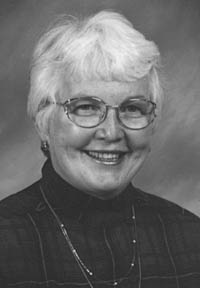
|
The 2001
D.M.T. All-Class Reunion The Des Moines Township Alumni Association met at 5 p.m. for social hour and dinner at the Countryside Café in Rolfe. There were 51 present from Iowa, Minnesota, Missouri, and Arizona. The DMT school district was officially begun on April 14, 1916. The township’s one-room schools were moved during the summer of 1916 from outlying sections to the present site of the DMT building. Connie Jensen of rural Rolfe remembers her school being moved from the corner north of her home and wondering if or where she would be going to school. That fall, she attended school in the central location in Section 15 where the five, one-room schools had been relocated. The new brick building was erected for the 1918-1919 school year. The last class graduated in 1959. |
||
|
Charles Lehnus who resides at the Pocahontas Care Center was a member of that first graduating class and recently celebrated his 100th birthday. Marie Nielsen Miller, who will celebrate her 100th birthday on August 22 (2001) and resides at Arlington Place in Pocahontas, was a member of the class of 1921. She was planning to attend the banquet, but due to a fall was unable to come. Loren Thompson welcomed the former graduates, and Karen Kerns offered the table prayer. After the meal, the graduates shared memories of their school days with the group. A pleasant time was enjoyed by all, and everyone is looking forward to another "get-together" next year. |
|||
|
|
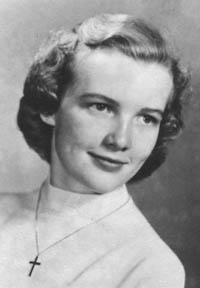
|
Audio Interview To listen to a fun and reflective interview with Karen Kerns about the recent D.M.T. reunion and other thoughts about the D.M.T. experience and changes in rural and small town life, go to our audio gallery. You will need to have the Real Audio software installed on your computer to access the files. We do plan to give a CD of the interview to the Rolfe library where Karen works. |
|
|
Dancing at DMT by
Deane C. Gunderson of rural Rolfe
(Editor's note: Deane C. Gunderson originally wrote the following column for the Rolfe Arrow in 1976 as part of his series called Bubbles in the Wine. We are posting a few of his columns at the rate of about one a month. Click here to read more of his work.)
Wednesday night after the Rolfe High musical two couples joined us in going to the D.M.T. Ballroom. The crowd was a nice size, the music was great and the people were having a good time. We stayed until closing and didn’t see a hint of rowdiness. This writer considers himself the world’ worst Arthur Murray and so was intrigued with the people that had some expertise in the graceful art of dancing. Russell Ives, Phil Brinkman and I speculated on the average age in attendance Wednesday night and came up with about 39 - not a Jack Benny - although there were several of Jack’s honest vintage there. The music was furnished by the Jane Russell band. Jane and Russell Thorson are a handsome pair and with a son and daughter play a great variety of music. Polkas and the great music of the 40’s and 50’s had sizable spots in the program. Russell Thorson did travel this part of the country selling for the Radio Trade Supply Co. of Fort Dodge. Until the band part became a steady diet he and Jane had a little time to indulge in duplicate bridge at the Fort Dodge Bridge Club. Not so lately. The D.M.T. building facilities seem to lend themselves neatly to being a ballroom. The floor is great, and there is plenty of room for tables and dancing. I didn’t sample the food except the onion rings. They were good and I bet the rest was too. The Rolfe Centennial Book gives a pretty good account of the D.M.T. school history but it does leave out one part, the frame building years. The township voted in April 1916 to consolidate the eight rural school districts. However, it was not until some time during the school year of 1918-1919 that the brick building was ready for occupancy. In the summer of 1916 Al Ralph, working at night during the threshing season, used his steam engine to pull six of the eight one room school buildings from their various locations to the present D.M.T. site. For two years, starting with grades 1-10 in the year 1916-1917 the school operated at the central site, but using the one room buildings. One building was used as a high school, and several others were used for two or three grades each. Sometime during the 1918-1919 school year the new brick building was occupied. Two of the one room buildings were used for a janitor’s home and for the superintendent’s home, at least in later years. They are probably the frame buildings that are still there. The first graduating class (1919) consisted of Chas. H. Lehnus, William R. Fisher, Melvin E. Struthers, Chester C. Harris, and Vinton Stinton. The early school busses were horse drawn and at the very first the students were transported to school in the ordinary farm wagons. Later enclosed vehicles were used. In 1969 the school closed the D.M.T. attendance center. The board member asked Swede Vote to check on whether it would be possible to move the gymnasium part of D.M.T. to the school grounds at Rolfe. The conclusion was that it was impractical because of the nature of the construction. The roof and the rafters could probably have been moved as a unit, but there wouldn’t be enough of the total structure to make it worthwhile. When Swede declines you know it’s not a good idea. I guess, though, that now you might say that D.M.T. is on the move again. |
|||
|
(Editor's note: the photo at the right of the D.M.T. school site is one that I took in the 1990s of several of the abandoned schools in Pocahontas County. The older, main brick part of the building had been razed with only the gymnasium left. I have fond memories of consolidating with D.M.T. because the Rolfe schools began girl's basketball when I was in ninth grade. |
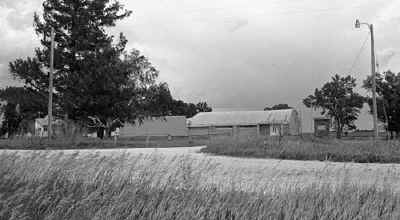
|
||
|
I enjoyed the opportunity to play ball and appreciated the new friendships. We rotated practice sites, working out one week at Rolfe then the next week going to D.M.T. In Karen's interview, she speaks of the cookies and milk that the school cooks left for the players to consume after practice. Gosh, I always thought that my peers and I were stealing cookies from the refrigerator in the home economics room. We probably were stealing, but do you suppose that the cookies really were meant for us. I also remember the red and gray uniforms that were a hold over from D.M.T. that we wore for Rolfe's first year of girls' basketball.) |
|||
|
The Schools of Pocahontas County The photo at the left is of the monument and flag that stands where the Havelock school building once existed. The bottom photo is of the Plover school site. How many schools did Pocahontas County once have? Let's see. There was D.M.T., Rolfe, Plover, Havelock, Laurens, Pocahontas, Pocahontas Sacred Heart, Fonda, Fonda O.L.G.C., Ware, Palmer, and Gilmore City which was on the border between Pocahontas County and Humboldt County. I believe there are now two high schools in the county — at Pocahontas and Laurens. I recall that the county 4-H program held a boys' basketball tournament at the Ware school where the circles of the free throw lanes overlapped in the center of the court. You may click on the photos for a larger view. And if you have more information about the schools of Pocahontas County that you would like to share, please send it to us. |
|||
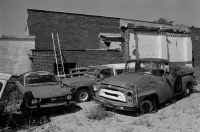
|
|||
|
The Loss of a
Rural Heritage (Note: When I was going through my computer files to find the photos of the D.M.T., Havelock, and Plover schools, I recalled writing a piece several years ago about abandoned school buildings. That prompted me to looked for that material, but it was not to be found. Instead, I came across the following essay I wrote in1990 after earning a seminary degree in northern California and making my home in St. Helena in the Napa Valley for several years. At the time, I was struggling with whether to move back to Iowa or not and whether to continue photographing and otherwise documenting rural life. Little did I realize that the change happening then — 11 years ago — would continue to escalate. Click here to go to that essay.) |
|||
|
|||

